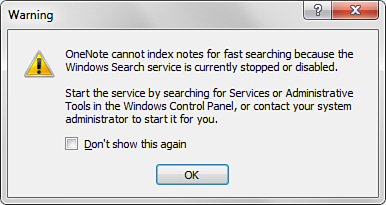Troubleshooting Problems with Search
The search features in OneNote depend on the Instant
Search component in the latest versions of Microsoft Windows. If you
installed OneNote 2010 on a Windows 7 or Windows Vista computer, the
search features should work as intended without any action on your part.
However, if you’re using OneNote 2010 on a computer
that you’re sharing with other people, it’s possible that another
person has turned on or off one or more search features. Similarly, if
you’re still using an outdated operating system like Windows XP, you
might need to manually install one of the search components.
To verify that OneNote has everything it needs to
use Instant Search features, complete either or both of the following
procedures.
To verify that the Instant Search component is installed, do the following:
1. | Click the File tab and then click Options.
|
2. | In the OneNote Options dialog box that opens, click the Advanced category on the left.
|
3. | On
the right, scroll down to the Search heading and look for a button
labeled Install Instant Search. If this button can be clicked, then you
did not have Instant Search installed. Complete the installation by
following any onscreen prompts.
|
4. | Click OK.
|
|
If the Install Instant Search button appears grayed
out, it means that this component is already properly installed and
that you don’t need to do anything else here. In this case, click OK to
close the OneNote Options dialog box.
|
If you verified that Instant Search was installed but you see a Warning dialog box a few minutes after you start OneNote (see Figure 5), a secondary component may be turned off in Windows.

You can restart this component by doing the following:
1. | In Windows 7, click the Start button.
|
2. | In the Search box at the bottom of the Start menu, type the word Services and wait for the word to appear near the top of the search results window on the Start menu.
|
3. | In the search results list, highlight the word Services (do not highlight other results, such as Component Services), and then press Enter.
|
4. | Maximize the Services window that appears.
|
5. | In the list, scroll down until you see Windows Search in the Name column and then double-click the words Windows Search.
|
6. | In
the Windows Search Properties dialog box that opens, make sure that the
Startup type option is set to Automatic (Delayed Start). If it isn’t,
click the drop-down menu and select this option from the list.
|
7. | If the Service Status further below is set to Stopped, click the Start button underneath this text.
|
8. | Click OK to close the Windows Search Properties dialog box.
|
9. | Restart OneNote 2010.
|
|
Unlike the Instant Search component, which must be
installed, the Windows Search service does not have to be running if
you’re content with slower searches in OneNote. For example, if your
computer or laptop is equipped with a Solid State Drive (SSD) instead
of a regular hard drive, it’s possible that Windows Search indexing was
turned off by the manufacturer. SSD drives are memory chip-based hard
drives with no moving parts. Because of this, their performance is so
fast that search indexing is usually not necessary. If you have an SSD
drive and you want to keep search indexing disabled, you can click the
Don’t Show This Again check box in the Warning dialog box (see Figure 5)
to tell OneNote that you’ve acknowledged the warning and that you’re
fine with normal searching instead of Instant Searching. The high
performance of an SSD hard drive will more than make up for the
difference.
|
The
benefits that all of these features avail you make it easy to
understand why keeping all of your stuff in OneNote is your best step
to improving your personal organization at work, at school, or at
home—even if you’re not a particularly organized person.
You can choose to use OneNote’s organizational
features to help you and others use and benefit from the information
that you’ve collected with OneNote. If you don’t want to bother with
organizing your notes, it’s perfectly fine to rely exclusively on
search. The benefits of OneNote’s search feature may well keep amazing
you, even after you’ve used it for a while. It’s the best reason for
keeping all of your notes, research, and information in OneNote, even
if that information originated in other places.